Lg Acq058pl, Hblg5200e, Hblg6000r, Kg5200er, Acq052pk Owner's Manual
...
website http://www.lgservice.com
LG
LG Room
Air Conditioner
SERVICE MANUAL
MODEL: ACQ058PL |
LW7000R |
KG5200ER |
WM-5031 |
LW5200ER |
LW050CE |
WG5200ER |
LWJ0515PAG |
WG6000R |
LW5200R |
KG6000R
M5404R
WG5200R
M6004R
HBLG6000R
HBLG5200E
ACQ052PK
CAUTION
•BEFORE SERVICING THE UNIT, READ THE SAFETY PRECAUTIONS IN THIS MANUAL.
•ONLY FOR AUTHORIZED SERVICE PERSONNEL.
CONTENTS |
|
1. PREFACE ....................................................................................................................................................................... |
2 |
1.1 FEATURES ........................................................................................................................................................................ |
2 |
1.2 SPECIFICATIONS ............................................................................................................................................................. |
3 |
1.3 SAFETY PRECAUTIONS ................................................................................................................................................. |
3 |
1.4 INSULATION RESISTANCE TEST .................................................................................................................................... |
3 |
1.5 LOCATIONS OF CONTROLS ........................................................................................................................................... |
4 |
2. DISASSEMBLY INSTRUCTIONS .................................................................................................................... |
6 |
2.1 MECHANICAL PARTS ...................................................................................................................................................... |
6 |
2.1.1 FRONT GRILLE ....................................................................................................................................................... |
6 |
2.1.2 CABINET................................................................................................................................................................... |
6 |
2.1.3 CONTROL BOARD ................................................................................................................................................... |
6 |
2.2 AIR HANDLING PARTS .................................................................................................................................................... |
7 |
2.2.1 AIR GUIDE UPPER................................................................................................................................................... |
7 |
2.2.2 ORIFICE, TURBO FAN AND FAN............................................................................................................................. |
7 |
2.2.3 MOTOR .................................................................................................................................................................... |
8 |
2.2.4 AIR GUIDE ................................................................................................................................................................ |
8 |
2.3 ELECTRICAL PARTS ....................................................................................................................................................... |
8 |
2.3.1 OVERLOAD PROTECTOR ...................................................................................................................................... |
8 |
2.3.2 COMPRESSOR ........................................................................................................................................................ |
9 |
2.3.3 CAPACITOR ............................................................................................................................................................. |
9 |
2.3.4 THERMISTOR........................................................................................................................................................... |
9 |
2.3.5 CONTROL PANEL..................................................................................................................................................... |
9 |
2.3.6 POWER CORD ...................................................................................................................................................... |
10 |
2.4 REFRIGERANT CYCLE ............................................................................................................................................ |
10 |
2.4.1 CONDENSER ........................................................................................................................................................ |
10 |
2.4.2 EVAPORATOR ....................................................................................................................................................... |
10 |
2.4.3 CAPILLARY TUBE ................................................................................................................................................. |
11 |
3. INSTALLATION ......................................................................................................................................................... |
13 |
3.1 SELECT THE BEST LOCATION ..................................................................................................................................... |
13 |
3.2 HOW TO INSTALL .......................................................................................................................................................... |
13 |
3.3 ELECTRICAL DATA ..................................................................................................................................................... |
16 |
4. TROUBLESHOOTING GUIDE ........................................................................................................................ |
16 |
4.1 OUTSIDE DIMENSIONS ................................................................................................................................................. |
16 |
4.2 PIPING SYSTEM ............................................................................................................................................................ |
17 |
4.3 TROUBLESHOOTING GUIDE ........................................................................................................................................ |
18 |
5. SCHEMATIC DIAGRAM ...................................................................................................................................... |
26 |
5.1 CIRCUIT DIAGRAM......................................................................................................................................................... |
26 |
5.2 ELECTRONIC CONTROL DEVICE ................................................................................................................................. |
27 |
5.3 COMPONENTS LOCATION(FOR MAIN P.W.B ASM)............................................................................................................... |
28 |
5.4 COMPONENTS LOCATION(FOR DISPLAY P.W.B ASM) ......................................................................................................... |
28 |
6. EXPLODED VIEW ................................................................................................................................................... |
29 |
7. SPECIFICATION AND PARTS LIST ............................................................................................................ |
30 |
—2—
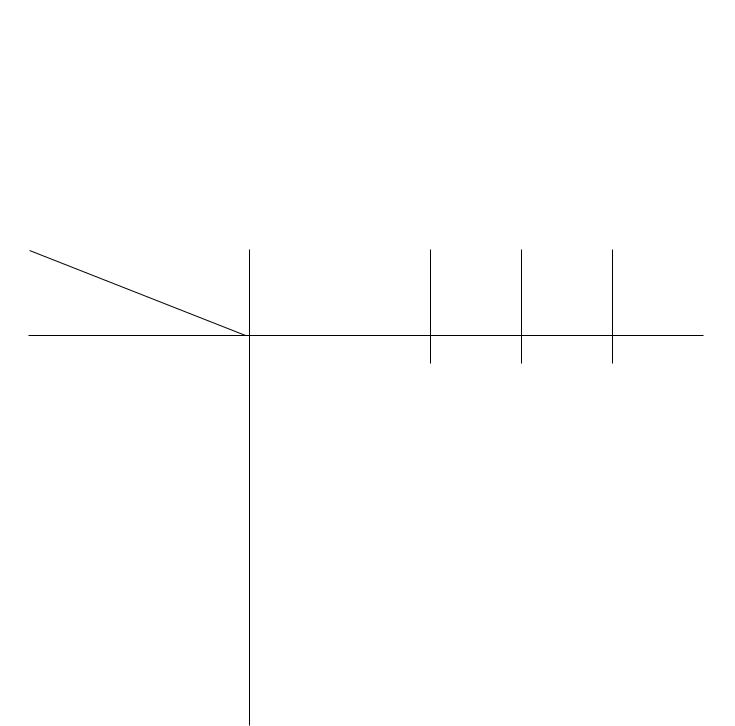
1. PREFACE
This service manual provides various service information, including the mechanical and electrical parts, etc. This room air conditioner was manufactured and assembled under a strict quality control system.
The refrigerant is charged at the factory. Be sure to read the safety precautions prior to servicing the unit.
1.1 FEATURES
•DESIGNED FOR COOLING ONLY
•POWERFUL AND INCREDIBLE COOLING
•TOP-DOWN CHASSIS FOR THE SIMPLE INSTALLATION AND SERVICE
•WASHABLE ONE-TOUCH FILTER
•COMPACT SIZE
1.2 SPECIFICATIONS
MODELS |
WG5200ER, |
|
|
|
WG5200R |
|
|
LW5200ER, |
|
|
|
ACQ052PK |
WG6000R |
|
|
|
|
|
|
|
|||
|
HBLG5200E, |
LW050CE |
|
M5404R |
M6004R |
LW7000R |
|
|
LWC051JGMK2 |
|
WM5031 |
KG6000R |
|||
|
|
|
|
|
|||
ITEMS |
KG5200ER |
|
|
|
LWJ0515PAG |
HBLG6000R |
|
ACQ058PL |
|
|
|
LW5200R |
|
|
|
COOLING CAPACITY (BTU/h) |
5,200 |
5,050 |
|
5,250 |
6,000 |
76,000 |
|
|
|
|
|
|
|
|
|
POWER SUPPLY (Phase, V, Hz) |
|
|
|
|
1ø, 115V, 60HZ |
|
|
|
|
|
|
|
|
|
|
INPUT (W) |
470/480 |
520 |
|
|
540 |
620 |
720 |
|
|
|
|
|
|
|
|
OPERATING CURRENT (AMP.) |
4.3/4.4 |
4.8 |
|
|
5.0 |
5.8 |
6.7 |
|
|
|
|
|
|
|
|
REFRIGERANT CONTROL |
|
|
|
CAPILLARY TUBE |
|
||
|
|
|
|
|
|
||
REFRIGERANT CHARGE (R-22) |
330g (11.6 Oz) |
220g(7.8 Oz) |
235g (8.3 Oz) |
315g (11.1 Oz) |
|||
|
|
|
|
|
|
|
|
INSIDE FAN |
|
|
|
|
TURBO |
|
|
|
|
|
|
|
|
||
OUTSIDE FAN |
|
PROPELLER FAN WITH SLINGER RING |
|
||||
|
|
|
|
|
|
|
|
AIR DISCHARGE |
|
|
2-WAY (RIGHT AND LEFT) |
|
|||
|
|
|
|
|
|
|
|
CHASSIS |
|
|
|
|
TOP-DOWN |
|
|
|
|
|
|
|
|
||
PROTECTOR |
• OVERLOAD PROTECTOR FOR COMPRESSOR |
|
|||||
• INTERNAL PROTECTOR FOR FAN MOTOR |
|
||||||
|
|
||||||
|
|
|
|
|
|
|
|
TEMPERATURE CONTROL |
|
|
|
|
THERMISTOR |
|
|
|
|
|
|
|
|
||
ROTARY SWITCH |
5 POSITIONS (LOW FAN, HIGH FAN, OFF, HIGH COOL, LOW COOL) |
||||||
|
|
|
|
|
|
||
FAN MOTOR |
6 POLES, 21W |
6 POLES, 19W |
6 POLES, 21W |
6 POLES, 27W |
|||
|
|
|
|
|
|
|
|
• NOTE: Specifications are subject to minor change without notice for further improvement.
1.3 SAFETY PRECAUTIONS |
1.4 INSULATION RESISTANCE TEST |
1.When servicing, set the POWER of CONTROL BOARD to Off and unplug the power cord.
2.Observe the original lead dress.
If a short circuit is found, replace all parts which have been overheated or damaged by the short circuit.
3.After servicing, make an insulation resistance test to prevent the customer's exposure to shock hazards.
1.Unplug the power cord and connect a jumper between 2 pins (black and white).
2.The grounding conductor (green or green and yellow) is to be open.
3.Measure the resistance value with an ohm meter between the jumpered lead and each exposed metallic part on the equipment at all Mode [except POWER OFF].
4.The value should be over 1 MΩ.
—3—
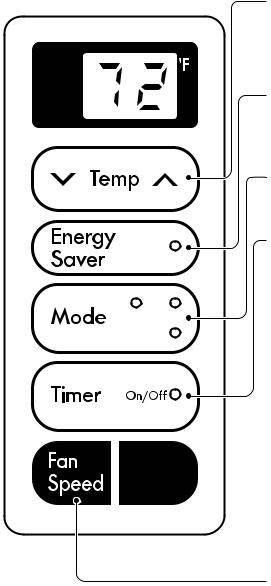
1.5 LOCATIONS OF CONTROLS
1.5.1 CONTROLS
TEMPERATURE SETTING
• This button can automatically control the temperature
of the room. The temperature can be set within a range of 60°F(16°C) to 86°F(30°C) by 1°F(1°C).
Select the lower number for lower temperature of the room.
ENERGY SAVER
The fan stops when the compressor stops cooling.
• Approximately every 3 minutes the fan will turn on and check the room air to determine if cooling is needed.
MODE
• Everytime you push this button, it will toggle between COOL, FAN, DRY or FAN, COOL.
ON/OFF TIMER
Dry Fan
Cool
- STOPPING OPERATION
•Everytime you push this button, when the unit is operating, timer is set as follows.
(1Hour  2Hours
2Hours  3Hours
3Hours  4Hours
4Hours 5Hours
5Hours 6Hours
6Hours 
7Hours  8Hours
8Hours  9Hours
9Hours  10Hours
10Hours  11Hours
11Hours  12Hours
12Hours  Cancel)
Cancel)
•The Setting Temperature will be raised by 2°F(1°C) 30min. later and by 2°F(1°C) after another 30 min.
- STARTING OPERATION
• Everytime you push this button, when the unit is not operating, timer is set as follow.
(1Hour  2Hours
2Hours  3Hours
3Hours  4Hours
4Hours 5Hours
5Hours 6Hours
6Hours 
7Hours 8Hours
8Hours  9Hours
9Hours  10Hours
10Hours  11Hours
11Hours  12Hours
12Hours  Cancel)
Cancel)



 POWER
POWER
•To turn the unit ON, push the button. To turn the unit OFF, push the button again.
•This button takes priority over any other buttons.
•When you first turn it on, the unit is on the High cool mode and the temp. at 72°F(22°C).
FAN SPEED
•Everytime you push this button it is set as follows. {High(F2)  Low(F1)
Low(F1)  High(F2)...} or
High(F2)...} or
{High(F3)  Mid(F2)
Mid(F2)  Low(F1)
Low(F1)  High(F3)...}.
High(F3)...}.
—4—
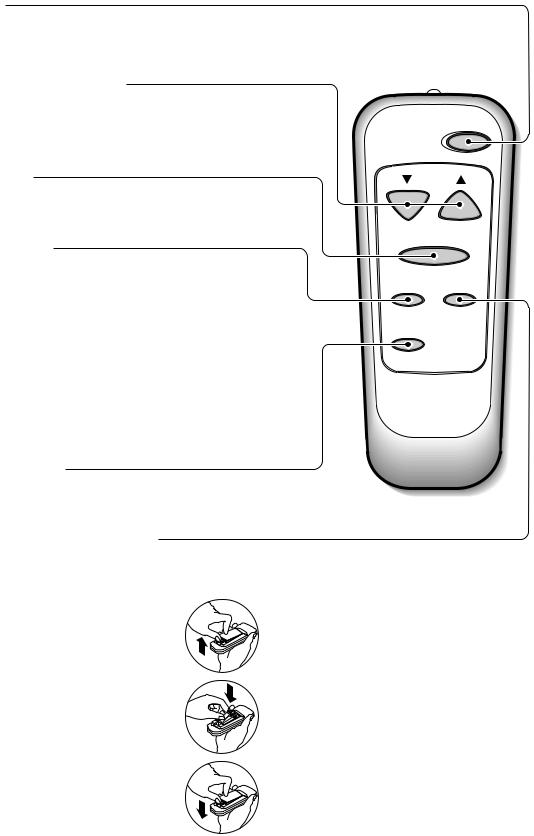
1.5.2 REMOTE CONTROLLER
POWER
•To turn the Set ON, push the button. To turn the Set OFF, push the button again.
•This button takes priority over any other buttons.
•When you first turn it on, the Set is on the High cool mode and the temp. at 72°F(22°C).
TEMPERATURE SETTING
•This button can automatically control the temperature of the room. The temperature can be set within a range of 60°F(16°C) to 86°F(30°C) by 1°F(1°C).
Select the lower number for lower temperature of the room.
FAN SPEED
•Everytime you push this button it is set as follows. {High(F2)  Low(F1)
Low(F1)  High(F2) or
High(F2) or
{High(F3)  Mid(F2)
Mid(F2)  Low(F1)
Low(F1)  High(F3)...}
High(F3)...}
ON/OFF TIMER
- STOPPING OPERATION
•Everytime you push this button, when the set is operating, timer is set as follows.
(1Hour  2Hours
2Hours  3Hours
3Hours  4Hours
4Hours  5Hours
5Hours  6Hours
6Hours 
7Hours  8Hours
8Hours  9Hours
9Hours  10Hours
10Hours  11Hours
11Hours  12Hours
12Hours Cancel)
Cancel)
•The Setting Temperature will be raised by 2°F(1°C) 30min. later and by 2°F(1°C) after another 30 min.
- STARTING OPERATION
• Everytime you push this button, when the set is not operating, timer is set as follow.
(1Hour  2Hours
2Hours  3Hours
3Hours  4Hours
4Hours 5Hours
5Hours  6Hours
6Hours 
7Hours  8Hours
8Hours  9Hours
9Hours  10Hours
10Hours  11Hours
11Hours  12Hours
12Hours  Cancel)
Cancel)
ENERGY SAVER
The fan stops when the compressor stops cooling.
•Approximately every 3 minutes the fan will turn on and check the room air to determine if cooling is needed.
COOL/FAN/DRY or COOL/FAN
• Everytime you push this button, it will toggle between COOL, FAN and DRY.
Power
Temp
Fan Speed
Timer Mode
Energy
Saver
How to Insert Batteries
1.Remove the cover from the back of the remote controller
2.Insert two batteries.
•Be sure that the (+) and (-) directions are correct.
•Be sure that both batteries are new.
3.Re-attach the cover.
•Do not use rechargeable batteries. Such batteries
differ from standard dry cells in shape, dimensions, and performance.
•Remove the batteries from the remote controller if the air conditioner is not going to be used for an extended length of time.
—5—
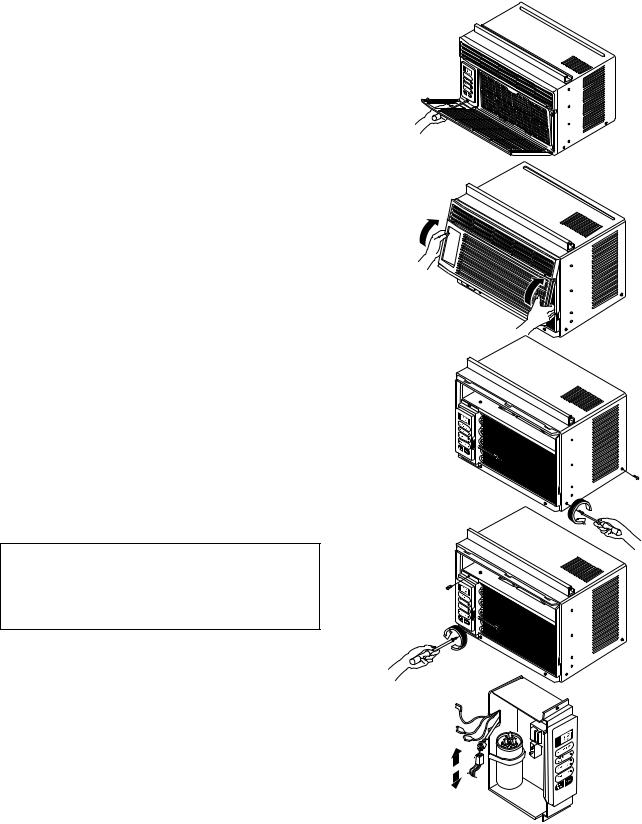
2. DISASSEMBLY INSTRUCTIONS
2.1 MECHANICAL PARTS
2.1.1 FRONT GRILLE Figure 1
1.Disconnect the unit from source of power.
2.Using a screwdriver, remove the screw that
secures the front grille to control board. (See Figure 1)
3. Push the front grille up from the bottom. Pull the top of the front grille away from the cabinet as the top tabs lift out of their slots. (See Figure 2)
4.Replace the grille by placing the tabs in the slots and push the grille until it snaps into place.
Figure 2
2.1.2 CABINET
1. Disconnect the unit from the power source.
2. Remove the front grille. (Refer to section 2.1.1) 3. Remove 9 screws that secure the cabinet to the
base pan and condenser. (See Figure 3)
4. Lift the cabinet from the unit.
Figure 3
5. Re-install by referring to the procedures above.
2.1.3 CONTROL BOARD
1.Disconnect the unit from the power source.
2.Remove the front grille. (Refer to Section 2.1.1)
3.Remove the cabinet. (Refer to Section 2.1.2)
4.Remove 2 screws that secure the control board to base pan and air guide. (See Figure 4)
5.Pull the control board toward yourself.
NOTE : Controls, wires, and capacitor are now accessible for servicing. Discharge the capacitor before servicing. See step
2.3.3on page 9 for procedures.
6.Disconnect one housing terminal and 3 wires for the fan motor and compressor. (See Figure 5)
7.Re-install components by referring to procedures above. (Refer to circuit diagram on page 26 in this manual or inside control board.)
Figure 4
Figure 5
—6—

2.2 AIR HANDLING PARTS |
Figure 6 |
2.2.1 AIR GUIDE UPPER
1. Disconnect the unit from the power source.
2. Remove the front grille. (Refer to Section 2.1.1)
3. Remove the cabinet. (Refer to Section 2.1.2)
4. Remove the control board. (Refer to Section 2.1.3)
5. Remove 2 screws that secure the brace to air guide upper and shroud. (See Figure 6)
6. Remove 2 screws that secure the air guide upper to air guide lower. (See Figure 6)
7.Lift air guide upper upward.
8.Re-install by referring to the procedures above.
Figure 7
2.2.2 ORIFICE, TURBO FAN AND FAN
1.Disconnect the unit from the power source.
2.Remove the front grille. (Refer to Section 2.1.1)
3.Remove the cabinet. (Refer to Section 2.1.2)
4.Remove the control board. (Refer to Section 2.1.3)
5.Remove the air guide upper. (Refer to Section 2.2.1)
6.Remove 2 screws that secure the base pan to condenser. (See Figure 7)
7.Remove 2 screws that secures the shroud to channel of condenser.
8.Press the snap area of shroud with your thumbs. This allows you to remove it from the condenser.
9.Lift the compressor upward with the evaporator and condenser. (See Figure 7)
10.Remove the orfice by pushing the snap area of the air guide blower. (See Figure 8)
11.Remove the clamp springs which are clamped to the boss of fan and turbo fan by hand plier. (See Figure 9)
12.Pull the fan and turbo fan outward.
13.Remove the shroud.
14.Re-install by referring to the procedures above.
Figure 8
Figure 9
—7—
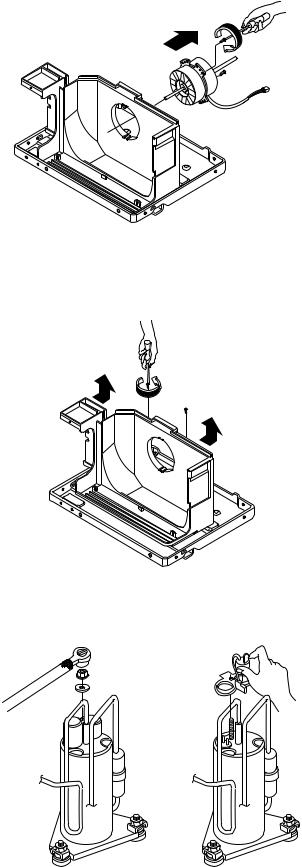
2.2.3 MOTOR
1.Disconnect the unit from the power source.
2.Remove the front grille. (Refer to Section 2.1.1)
3.Remove the cabinet. (Refer to Section 2.1.2)
4.Remove the control board. (Refer to Section 2.1.3)
5.Remove the air guide upper. (Refer to Section 2.2.1)
6.Remove the compressor, turbo fan, fan and shroud. (Refer to Section 2.2.2)
7.Remove 2 screws that secure the motor to the motor. (See Figure 10)
8.Remove the motor.
9.Re-install by referring to the procedures above.
2.2.4 AIR GUIDE
1.Disconnect the unit from the power source.
2.Remove the front grille. (Refer to Section 2.1.1)
3.Remove the cabinet. (Refer to Section 2.1.2)
4.Remove the control board. (Refer to Section 2.1.3)
5.Remove the air guide upper. (Refer to Section 2.2.1)
6.Remove the compressor, turbo fan, fan and shroud. (Refer to Section 2.2.2)
7.Remove the motor. (Refer to Section 2.2.3)
8.Remove 2 screws that secure the air guide to the base pan. (See Figure 11)
9.Push the air guide backward and lift it upward. (See Figure 11)
10.Re-install by referring to the procedures above.
2.3ELECTRICAL PARTS
2.3.1 OVERLOAD PROTECTOR
1.Remove the front grille and cabinet. (Refer to Section 2.1)
2.Remove the nut which fastens the terminal cover.
3.Remove the terminal cover.
4.Remove all the leads from the overload protector.
5.Remove the overload protector.
6.Re-install the components by referring to the removal procedure above.
(See Figure 12 and 13)
Figure 10
Figure 11
Figure 12 |
Figure 13 |
|
—8—

2.3.2 COMPRESSOR
1.Remove the front grille and cabinet. (Refer to Section 2.1.2)
2.Discharge the refrigerant by using a refrigerant recovery system.
3.Remove the overload protector. (Refer to Section 2.3.1)
4.After discharging the unit completely, unbrace the suction and discharge pipes at the compressor connections.
5.Remove 3 nuts which fasten the compressor.
6.Remove the compressor.
7.Re-install by referring to the removal procedure above. (See Figure 14)
2.3.3 CAPACITOR
1.Remove the cabinet. (Refer to Section 2.1.2)
2.Remove the control board. (Refer to Section 2.1.3)
3.Discharge the capacitor by placing a 20 KΩ resistor across the capacitor terminals.
4.Pull the capacitor upward.
5.Remove all the leads of capacitor terminals.
6.Re-install the components by referring to the removal procedure above. (See Figure 15)
Figure 14
Figure 15
2.3.4 THERMISTOR
1.Remove the cabinet. (Refer to Section 2.1.2)
2.Remove the control board. (Refer to Section 2.1.3)
3.Disconnect the thermistor terminals from main P.W.B assembly.
4.Remove the thermistor.
5.Re-install the components by referring to the removal procedure above. (See Figure 16)
2.3.5 CONTROL PANEL
1.Remove the cabinet. (Refer to Section 2.1.2)
2.Remove the control board. (Refer to Section 2.1.3)
3.Pull the control panel forward and pull out it.
4.Remove 2 lead wire terminals.
5.Re-install the components by referring to the removal procedure above. (See Figure 17)
Figure 16
Figure 17
—9—
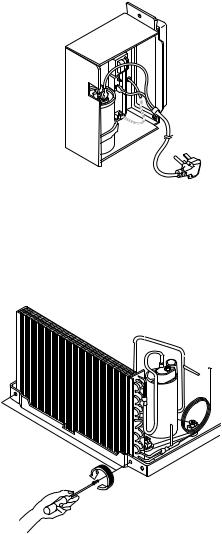
2.3.6 POWER CORD
1.Disconnect the unit from source of power.
2.Remove the front grille. (Refer to Section 2.1.1)
3.Remove the cabinet. (Refer to Section 2.1.2)
4.Remove 2 screws that secure control board to base pan and air guide. (Refer to Section 2.1.3)
5.Pulls the control board toward you.
6.Remove the grounding screw.
7.Remove a screw securing the clip with cord to the control board.
8.Pull the power cord.
9.Re-install by referring to procedures above.
2.4 REFRIGERANT CYCLE
2.4.1 CONDENSER
1.Remove the cabinet. (Refer to Section 2.1.2)
2.Discharge the refrigerant by using a refrigerant recovery system.
3.Remove 2 screws which fasten the condenser. (See Figure 19)
4.After discharging the refrigerant completely, unbraze the interconnecting tube at the condenser connections.
5.Remove the condenser.
6.Re-install by referring to the procedures above.
2.4.2 EVAPORATOR
1.Remove the cabinet. (Refer to Section 2.1.2)
2.Discharge the refrigerant by using a refrigerant recovery system.
3.Remove the air guide upper. (Refer to Section 2.2.1)
4.After discharging the refrigerant completely, unbraze the interconnecting tube at the evaporator connections.
5.Remove the evaporator.
6.Re-install by referring to the procedures above.
Figure 18
Figure19
—10—
2.4.3 CAPILLARY TUBE
1.Remove the cabinet. (Refer to Section 2.1.2)
2.Discharge the refrigerant by using a refrigerant recovery system.
3.Remove the air guide upper. (Refer to Section 2.2.1)
4.After discharging the refrigerant completely, unbraze the interconnecting tube of the capillary tube.
5.Remove the capillary tube.
6.Re-install by referring to the procedures above.
NOTES
Replacement of the refrigeration cycle.
1.When replacing the refrigerating cycle, be sure to discharge the refrigerant by using a refrigerant recovery system.
2.After discharging the unit completely, remove the desired components, and unbraze the pinch-off tubes.
3.Solder service valves into the pinch-off tube ports, leaving the valves open.
4.Solder the pinch-off tubes with service valves.
5.After completing the above procedures, the valve must be closed and left in place on the system for any subsequent procedures.
6.Evacuate as follows:
6-1. Connect the vacuum pump, as illustrated in figure 20A.
6-2. Start the vacuum pump. Slowly open manifold valves A and B with two full turns counterclockwise and leave the valves closed.
The vacuum pump is now pulling through valves A and B up to valve C by means of manifold and the entire system.
CAUTION : If high vacuum equipment is used, just crack valves A and B for a few minutes, then open slowly with the two full turns counter-clock- wise. This will keep oil from foaming and being drawn into the vacuum pump.
6-3. Operate the vacuum pump for 20 to 30 minutes, until 600 micron vacuum is obtained. Close valves A and B and observe vacuum gauge for a few minutes.
A rise in pressure would indicate a possible leak or moisture remaining in the system. With valves A and B closed, stop the vacuum pump.
6-4. Remove the hose from the vacuum pump and place it on the charging cylinder. See figure 20B. Open valve C.
Discharge the line at the manifold connection. 6-5. The system is now ready for final charging.
7.Recharge as follows:
7-1. Rotary compressor systems are charged from the high-side. If the total charge cannot be put in the high-side, the balance will be put in the suction line through the access valve which is installed as the system is opened.
7-2. Connect the charging cylinder as shown in figure 20B. With valve C open, discharge the hose at the manifold connection.
7-3. Open valve A and allow the proper charge to enter the system. Valve B is still closed.
7-4. If more charge is required, the high-side will not take it. Close valve A.
7-5. With the unit running, open valve B and add the balance of the charge.
a.Do not add the liquid refrigerant to the lowside.
b.Watch the low-side gauge, allow pressure to rise to 30 lbs.
c.Turn off valve B and allow the pressure to drop.
d.Repeat steps B and C until the balance of the charge is in the system.
7-6. When the unit is operating correctly, use the pinch-off tool with the unit still running and the clamp on the pinch-off tube. Using a tube cutter, cut the pinch-off tube about 2 inches from the pinch-off tool. Use sil-fos solder and solder the pinch-off tube closed. Turn off the unit, allow setting for a while and then test the leakage of the pinch-off connection.
—11—
